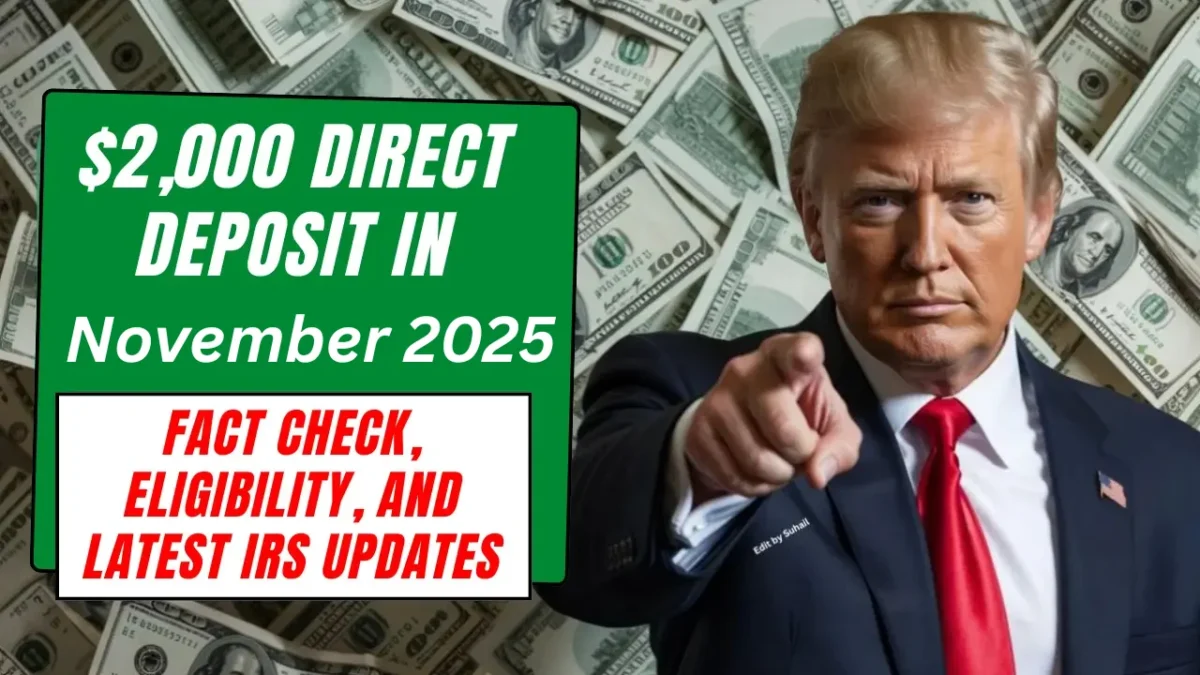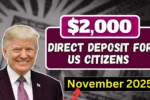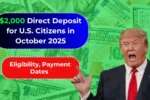$2,000 Direct Deposit:As 2025 enters its final months, there’s encouraging news for millions of Americans—a $2,000 direct deposit is expected to reach eligible U.S. citizens’ accounts this November. For families, seniors, and workers facing the challenges of high living costs, this new relief payment will bring hope and financial relief just before the festive sea
Here’s a complete breakdown of everything you need to know about this program—including eligibility requirements, payment deadlines, and IRS guidelines to ensure you receive your money without delay.
Overview of The $2,000 Direct Deposit
The $2,000 direct deposit payment is part of the federal government’s continued efforts to provide financial relief to citizens still struggling with inflation, housing costs, and other living expenses. Although it’s not officially called a “stimulus check,” its purpose is the same: to provide direct, one-time assistance to families most in need.
This payment will be distributed by the Internal Revenue Service (IRS) and the U.S. Treasury Department through the same trusted channels used for earlier relief programs, such as pandemic stimulus payments and cost-of-living adjustments for benefit recipients.
Its goal is to help Americans manage rising expenses at the end of the year—providing a timely boost that can help cover rent, groceries, utilities, and healthcare costs.
Who Is Eligible for the $2,000 Direct Deposit?
Eligibility for the November 2025 payment will depend on your income, tax filing status, and participation in federal assistance programs. Here’s what we know so far:
-
Income Requirements:
-
Single filers with annual incomes up to $75,000 qualify for the full $2,000 payment.
-
Married couples filing jointly earning up to $150,000 will receive the full amount.
-
Those earning above these limits may receive reduced payments based on their adjusted gross income (AGI).
-
-
Social Security, SSDI & VA Recipients:
-
Individuals receiving Supplemental Security Income (SSI), Social Security Disability Insurance (SSDI), or Veterans Affairs (VA) benefits are automatically eligible.
-
Payments for these recipients will be sent through their usual deposit method — either direct deposit or their Direct Express card.
-
-
Tax Filers with Dependents:
-
Families who claimed the Child Tax Credit (CTC) or Earned Income Tax Credit (EITC) on their 2024 tax return are likely to qualify for the $2,000 payment as well.
-
-
Citizenship and Residency:
-
The payment is limited to U.S. citizens and permanent residents with a valid Social Security number.
-
This approach ensures that funds reach individuals and families who need assistance most — especially those whose incomes haven’t kept up with rising costs.
$2,000 Direct Deposit For U.S. Citizens in November 2025 – Eligibility & Payment Details
When Will Payments be Sent?
The IRS and Treasury are preparing to distribute payments beginning in mid-November 2025, and most payments are expected before November 30, 2025.
The general timeline for how payments will be issued is as follows:
- Direct Deposit:
Most eligible recipients will receive their funds automatically between November 12 and November 26, 2025.
- Paper Check:
Those without a direct deposit system will receive checks by mail by late November or early December.
- Benefit Recipients:
SSI, SSDI, and VA beneficiaries may receive their funds on or around their regular benefit payment dates.
Once official distribution begins, you can check your status through the IRS “Get My Payment” tool or your “My Social Security Account.”
IRS Instructions for Receiving Payments
The IRS has outlined several key steps to ensure smooth payments:
- Keep Your Information Updated:
If your address, bank account, or filing status has recently changed, update it through the IRS.gov portal or the Social Security Administration (SSA) website.
2.File Your 2024 Tax Return:
Even if your income is low or zero, file your 2024 return to ensure you are included in the payment database. The IRS uses the latest tax filings to determine eligibility.
3. Beware of Scams:
The IRS will never ask you for banking details by phone, email, or text message. Any message claiming to “expedite your payment” or “register you for a program” is fraudulent.
4. Use official IRS tools:
When the payment portal reopens, use the “Get My Payment” tool to check your eligibility, update your information, or track your deposit.
$1400 PFD Stimulus Check 2025 – Eligibility, Payment Dates & How to Claim
Why This Payment is Important
For many Americans, this $2,000 direct deposit will come at the perfect time. Inflation has made essential goods more expensive, leaving countless families struggling to make ends meet. Senior citizens and veterans, in particular, have felt the pressure of rising healthcare and housing costs.
This relief payment:
- Can help pay overdue bills or rent.
- Can support small local businesses when consumers spend the funds.
- Can ease financial stress during the festive season.
Beyond the dollar amount, this program symbolizes hope and continued government commitment to the economic stability of ordinary Americans.
Final Thoughts
The $2,000 direct deposit for U.S. citizens in November 2025 is an important step toward keeping families financially stable amid economic challenges. Whether you’re retired, a working parent, or a veteran, this payment could make a real difference.
Make sure you keep your information updated with the IRS or Social Security Administration and monitor official channels to confirm payment dates.
Financial relief is coming soon – and this November, this extra $2,000 could prove helpful to millions of Americans.
FAQs
1. Is the $2,000 payment confirmed by the IRS?
While not yet officially confirmed, the program is reportedly in its final review phase, with distributions expected to begin in mid-November 2025.
2. Who qualifies for the payment?
Low- and middle-income taxpayers, Social Security recipients, veterans, and families with dependents may all qualify.
3. Do I need to apply for the payment?
No application is needed. Payments will be sent automatically based on IRS and SSA records.
4. Is this payment taxable?
No, this payment is non-taxable and will not affect future Social Security or SSI benefits.
5. How can I track my payment?
Visit the IRS “Get My Payment” portal or your My Social Security account for updates once the program launches.





